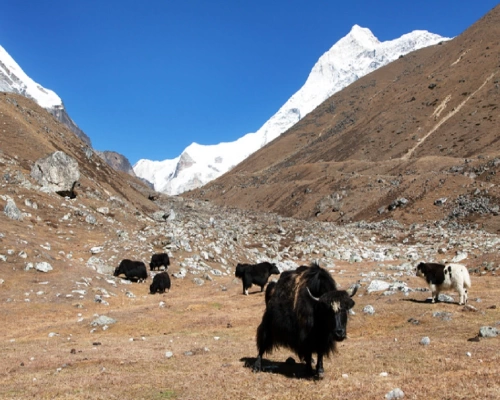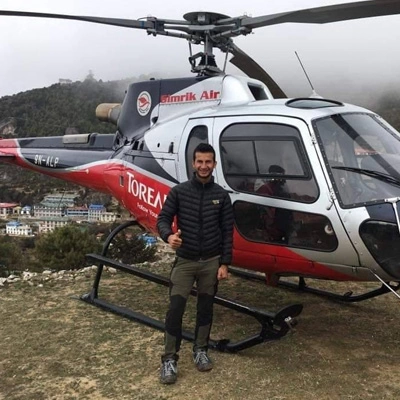The Makalu Base Camp Trek is one of the best off-the-beaten tracks and lies in the Himalayas of Nepal. This one is also longer and more challenging, and it undoubtedly is more demanding than most treks in Nepal. The treks leading to Makalu Base Camp normally last for not less than eight days, and the highest point of the trek is at 5,050m. Any trekkers then need to retrace for about 5 to 6 days on their way out on the same trail they used to access the park.
At the base camp, you get the feeling that you are sitting on the base of Mt. Makalu, and the mountain is right in front of you, not like when you are at the base camp of Mount Everest, where the mountain is not visible in front. Every morning, it becomes possible to observe how the sun rises behind the top of the fifth most prominent mountain in the world. From base camp, another short and easy climb to the higher ground gives one a view of Mount Everest and Lhotse. The Makalu Base Camp trekking is recommended for those people who are not interested in going through the standard routes of Nepal and want to trek amongst the giants.
Makalu is the fifth highest mountain in the world and is situated in the eastern part of Nepal with an altitude of 8,463 metres above sea level. You are indeed very fortunate to tread the paths of Makalu which pass through lush rhododendron forests. The Makalu Base Camp trekking is perfect for those who wish to trek in the region without being surrounded by large crowds of tourists and still experience the thrill of the whole trip.
This trek to Makalu base camp is an excellent chance to get acquainted with the locals and their traditions. This way, trekkers can meet with the locals and get some idea about their way of living in that area. Also, explore the cultural and social practices of the Gurung, Rai people, and Sherpas, the major inhabitants of the Makalu region. Explore Thai culture, Buddhism, and the way of living of the Thai people.
The 19-day trek to Makalu Base Camp begins with a flight from Kathmandu to Tumlingtar. Ascending through rhododendron forests, crossing suspension bridges on the Arun River, and passing by Chichila and Num Villages are some of the features of this trail. Walkers along this path might meet various persons or groups living there as well as get knowledge about their lifestyle. The more we go here, the harsher we find it in terms of landscape due to its increased elevation above sea level, characterised by a lack of vegetation and the presence of only hard rocks.
The trail goes through the Shipton La and Keke La passes that give an insight into the neighbouring hills. Trekking routes from Yangri Kharka, Langmale Kharka, and Shershong take the final destination to Makalu Base Camp at 4870m. On the way back, a steep descent to the Barun Valley leads back to the trail. Tumlingtar is where jeeps drop the trekkers to take them to Tumlingtar for the final flight to Kathmandu at the end of the trek in Num. This challenging trail provides beautiful scenery of the mountains, valleys, rivers, and people and leads to the fifth-highest mountain in the world.
At Adventure Altitude Treks, we are pleased to present the Makalu Base Camp Trek Detailed Itinerary at the best cost in 2024 and 2025. This package will be flexible depending on the trekkers. For details about the Makalu Base Camp Trek Package Cost, bookings, and more details, kindly contact us.
Makalu Base Camp Trek 19 Days Main Highlights
- Hike up to the Arun Valley – one of the world’s best valleys.
- Trek through rice paddies and even hike up the rocky slopes of the Virgin Himalayas.
- Enjoy mountain views, including Makalu, Everest, Chamlang, Lhotse, and other eastern summits such as Kanchenjunga.
- Some of the animals that can only be found in the wild and are endangered include the Red Panda, Snow Leopard, Musk Deer, and many other species.
- Explore Makalu Barun National Park.
- Trek along the colourful trails lined with rhododendron flowers in full bloom on both sides.
- Engage with people from other cultures, such as Rai, Gurung, Shingsawa, and Sherpa.
- Instead of choosing the most common and sometimes crowded hiking trails, you will have a quieter experience.
- The trip starts with a flight from Kathmandu to Tumlingtar, where one can get a view of the eastern Himalayas.
- While trekking, many monasteries and chortens are quite beautiful and serene; one can sit, relax, or even meditate after a long day of walking.
What Are The Benefits of Makalu Base Camp Trek 19 days Package With Us?
Some of the benefits of booking Makalu Base Camp Trek package with us are as follows:
- Airport pick-up and drop-off services are provided at no extra cost.
- The Adventure Altitude Treks duffle bag will be provided for the Trek
- The Adventure Altitude Treks T-shirt will be provided as a souvenir.
- A free trekking map of the Makalu Base Camp trekking trail.
- An oximeter is used to check the blood oxygen saturation while trekking during the expedition.
- Medical kits are available in case of an accident during the exercise.
- In Adventure Altitude Treks, luggage storage is free during the Trek if you have excess luggage.
- Trekking Guide assistance will be available from when you arrive in Kathmandu to when you reach Makalu Base Camp and beyond.
- The Trek can be booked for trekking in the autumn and spring seasons since these are the two best seasons for trekking.
- Maps and altitude charts of the treks are quite detailed, and all the routes are highlighted well.
What to Expect about Makalu Base Camp Trek?
Makalu Base Camp Trek is among the famous off-beat trekking in Nepal that takes you to the proximity of Mt. Makalu, the fifth-highest mountain in the world. Embarking on this trek takes you to the remote yet surreal landscape of lowlands, alpine meadows, high Himalayan passes, and mountains. Manaslu Base Camp is a long, arduous, and essential tea house trek, which is best for keen trekkers who prefer off-beat routes to established routes.
Makalu Base Camp Trek has everything one could get on a trek. It's still a fresh, least-hiked trek that offers a peaceful hiking experience throughout the year. The enriched bio-diversity of Makalu Barun National Park accompanies your peaceful trek. Moreover, you'll get the option of trekking to Everest Base Camp after crossing Sherpani Pass. You may not get the apple pie comfort during 19 trek days, but it rewards you uniquely. You'll live a life at Makalu Base Camp.
Makalu Base Camp Trek 19 Days Cost 2024, 2025 and 2026
The cost of the Makalu Base Camp Trek for 19 days with Adventure Altitude Treks ranges from $1790 to $2150 per person, depending on the number of travellers and the year. We have group travel rates for 2024, 2025, and 2026 for people who travel in groups. This cost includes accommodations, meals, and guiding services, among other expenses. We also have special packages for 2024, 2025, and 2026. For the current prices, please contact us and let us know the size of your group and the year you will be travelling. The group joining Makalu Base Camp Trek cost in 2024, 2025 and 2026 are as follows:
Pax | Cost Per Person | Inquiry |
1 - 1 | $ 2150 | Send Inquiry, Contact Us |
2-4 | $ 1850 | Send Inquiry, Contact Us |
5-10 | $ 1790 | Send Inquiry, Contact Us |




